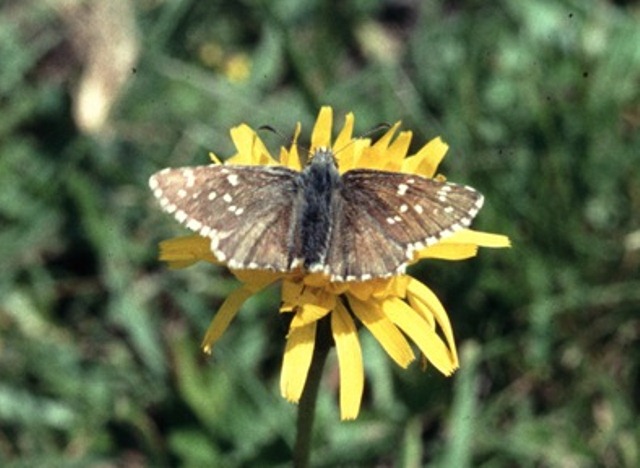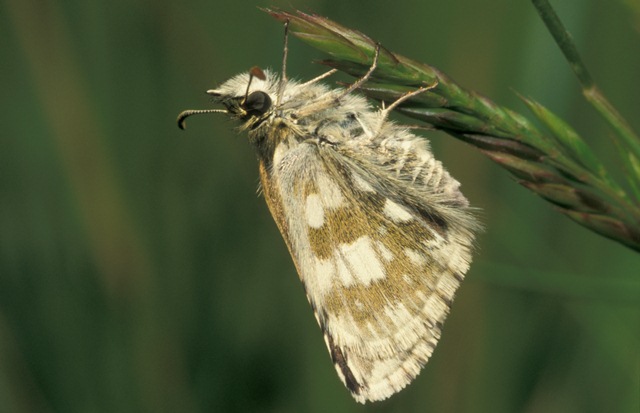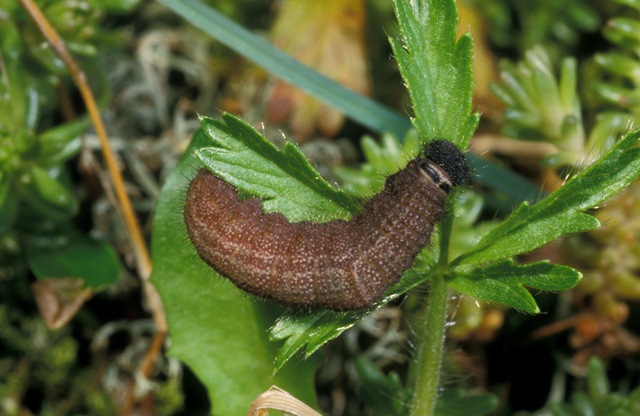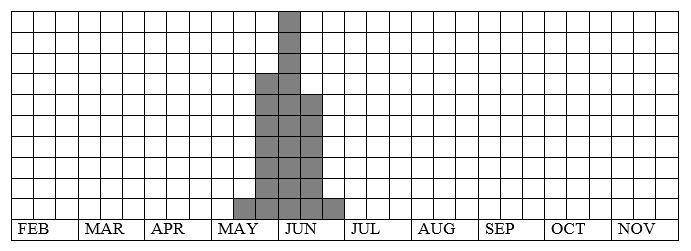|
13. Pyrgus serratulae (Rambur, 1840) / Olive skipper / Hesperiidae –Pyrginae
NL: groen dikkopje, voorjaarsspikkeldikkopje / D: Schwarzbrauner Würfelfalter, Steinrasen-Würfeldickkopf / F: haspérie de alchémille, l’olivâtre
  
Photographs: Sepp Weidemann, Frits Bink, Frits Bink ©.
Very small, wing length 13 (11-14) mm. The species is known from grassland in mountainous and subalpine climates and occurs very locally in Luxemburg and Wallonia on sites where there is snow cover in winter.
In lowlands the butterfly is on the wing from end-May until mid-June and peaks early-June. The European distribution is restricted to continental climate, amplitude 9 to 17. The required heat sum is 800°d and maximum tolerated 2000°d. This corresponds with climate windows of 23 weeks and 34 weeks.
The species occurs in grassland with medium tall grass with patches of bare soil.
Ecological characteristics
Behaviour over time
Overwintering: L4 larva in a cocoon.
Reproduction: oviposition starts after 7-8 days when the body contains about 45 eggs. Estimated potential reproduction twice as much.
Larval feeding periods: in summer 10 weeks from mid-June until end-September, after diapause in spring 8 weeks from early-March until early-June.
Generations: one.
Spreading of risk: not observed.
Life cycle: egg 15 (11-18) days; larva 46 weeks; pupa about 19 days.
Life span of adult: rather long, 3 weeks.
 
Photographs: Frits Bink ©.
Behaviour in space
From stay-at-home to migrant: stay-at-home, spatial requirement modest.
Finding a mate: both patrolling and perching behaviour was observed.
Orientation in the landscape: open field with short grassland.
Oviposition: on the underside of an old leaf.
Defence
Threats from other organisms: larva hides in a shelter of folded leaves and during overwintering in a cocoon in the litter.
Threats from the environment: because its distribution in Europe is restricted to mountainous and subalpine climate, it may be assumed that it is sensitive to heat and drought.
Feeding habits
Adult: nectar, all kind of flowers of herbs in the grassland.
Larva: feeds on the older leaves, ignores young ones.
Larval foodplants
Plant species: Rosaceae, cinquefoil species, e.g. Potentilla tabernaemontani, P. reptans, P. verna.
Journal
Rearing experiment based on specimen from grassland near Bayreuth, Germany.
Report
19 June 1985: five eggs, two just hatched, found on Potentilla tabernaemontani and P. repens in a mountainous Mesobromion vegetation, lightly grazed by cattle (Pyrgus malvae was also present at that locality).
1 July: remaining eggs hatched.
13 July: larvae in moult L2-3, red-brown coloured.
26 July: L4 larvae in diapause.
25 July: one larva had eaten a small amount.
19 October: larvae were in L4 in cocoons, which they repaired immediately after damage.
Overwintered outdoors.
26 January 1986: larvae taken indoors.
12 February: no feeding observed, only repairing of cocoons when damaged.
27 February: one larva had moulted and the other was in moult. Ate during the day in full sunshine.
15 March: larvae observed to bite through the stem of the leave and eat it later. Droppings are ejected 30 to 40 cm.
23 March: larvae constructed a more vertical shelter.
16 April: first larva pupated.
17 April: second larva pupated.
5 May: first adult appeared, female.
6 May: second female emerged, a cripple, egg load 72 very small eggs.
9 May: first female died, egg load 8 chorionated eggs and 48 very small ones.
Food plants used: Potentilla verna and P. reptans.
Table 13-1. Results of dissections

Table 13-2. Collection and observation localities
D, Bayreuth 49° 56’N – 11° 34’E, altitude 500m, 19 June 1985 (eggs, newly hatched larvae).
Fig. 13-1. Pyrgus serratulae, phenogram adapted from Ebert & Rennwald 1991b: 498.

Fig. 13-2. Pyrgus serratulae, habitat characteristics.

Fig. 13-3. Pyrgus serratulae, climate matrix, heat-sums 800 - 2000°d.

|










